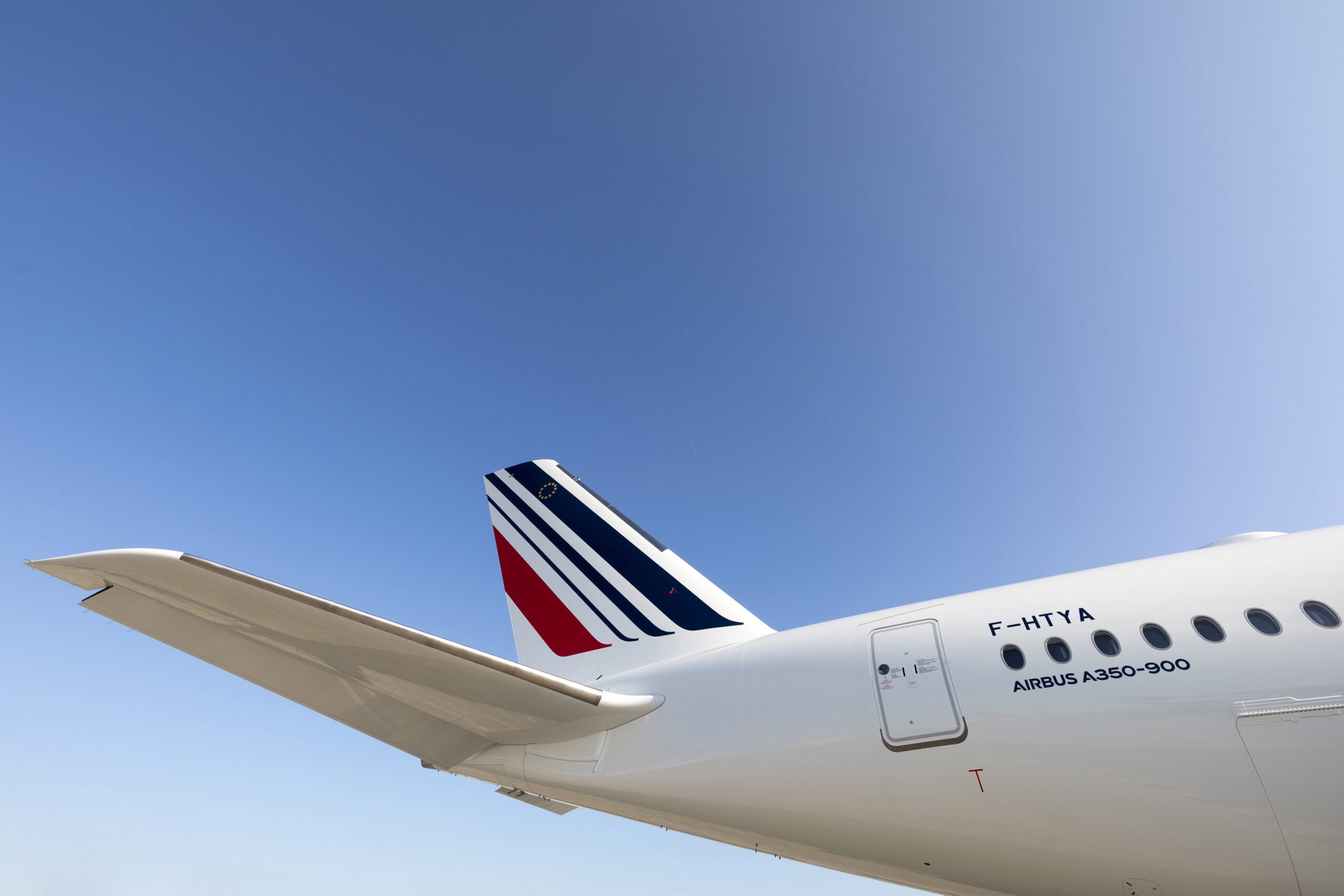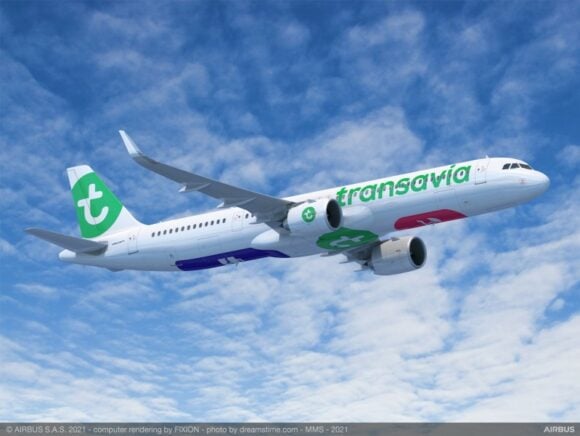
AirFrance A350 17 scaled
Air France-KLM is most happy with its Q4 results, which despite the effects of Omicron produced a positive operating result and good load factors. At 3.7 percent, the operating margin has been above the level of Q4 2019, the airline said on February 17. Air France-KLM happy with improvements in 2021.
The Group reported a €178 million operating profit in the October-December period compared to €-1.136 million in 2020. EBITDA was €827 million versus €-409 million. Revenues were up 104.7 percent to €4.838 billion. Thanks to reduced costs, this resulted in a net loss for the period of €127 million compared to €-1.001 billion in the same period in 2020.
For the full year, Air France-KLM reported a net loss of €3.294 billion compared to €-7.105 billion in 2020. The operating loss was €1.626 billion versus €-4.554 billion. EBITDA was €745 million versus €-1.695 billion in 2020. “We expected EBITDA to be slightly positive and ended the year at 745 million, significantly higher than we expected, so we are very happy with the results. For the first time in the crisis, we were better than in Q4 2019”, said Chief Financial Officer, Steven Zaat. Revenues were €14.315 billion, up from €11.088 billion. The cash flow was €225 million, the third quarter in a row it is positive.
Passenger numbers were up 31 percent to 44.7 million. In Q4, pax numbers were up 167 percent to sixteen million and passenger revenue units by 87 percent to €5.77 cents. Long-haul did well, with better yields than in 2019 and continued growth of the capacity. Load factors in Business Class and Economy are identical. Corporate travel is slowly getting back, especially on long-haul travel, but by the end of the year was still only fifty percent of 2019.
Although hit by Omicron in December, short and medium-haul routes in Europe were the best performers as was the network to Africa, the Caribbean, and the Indian Ocean. Capacity increased to 72 percent and load factors to 71 percent.
KLM produced a 127 million profit in Q4 of 2021. (Richard Schuurman)
KLM performs better than Air France
By airline, KLM (again) performed better. As it started its transformation and restructuring earlier than Air France, KLM recorded a €227 million full-year loss compared to €-1.154 billion in 2020, improving its operating margin to -3.7 percent from -22.5 percent. EBITDA was €695 million (2020: €-75 million), with revenues at €6.065 billion (€5.120 billion). In Q4, KLM produced a €127 million profit compared to €-152 million in the same period of 2020.
Air France reported a full-year loss of €1.403 billion compared to €-3.389 billion in 2020. Its operating margin is still -16 percent, although an improvement over -52.8 percent. EBITDA was €46 million versus €-1.609 billion, with revenues of €8.744 billion (2020: €6.415 billion). AF’s Q4 result showed a €52 million profit (€-988 million). But Zaat added that Air France is catching up on the transformation. It improved its operating margin by one billion year-over-year and performed better in Q4 2021 compared to Q4 2019.
Transavia benefitted from strong demand for leisure traffic at the end of the year, notably for Transavia France. The Dutch subsidiary was affected by travel restrictions on its home market and to other key markets, notably Morocco. The two Transavia’s produced a full-year loss of €150 million compared to €-299 million in 2020 or €-37 million in Q4. Revenues ended at €1.011 billion, up from €606 million. The airlines carried 70.1 percent more passengers to 8.8 million at a load factor of 75 percent, with a capacity of Transavia France close to 2019 levels in Q3 and Q4.
Cargo outperformed previous years and saw revenues increase to €3.588 billion, up from 2.568 billion in 2020. Tons carried were 1.053 billion compared to 880 million, with capacity is Available Tons Kilometers up 13.3 percent to 14.5 million. The full-year contribution of cargo tripled versus 2019 and continues to improve. “We are currently already doing €400 million better in revenues than in Q4, so the cargo business is doing very strong despite the fact that we increased belly capacity”, said Steven Zaat.
Lower external revenues of eighteen percent impacted Maintenance & Engineering, resulting in an operating profit of €88 million that still reflects favorably compared to €-543 million in 2020.
Paying back state aid as soon as is practicable
Both Group CEO Benjamin Smith and CFO Steven Zaat said that Air France-KLM is accelerating its “historical transformation” to deliver the medium-term financial targets set for 2024. Last year, it already reduced staff costs by twenty percent to €1.5 billion (excluding state support) and brought the workforce down by seventeen percent at KLM and sixteen percent at Air France. FTE reductions will continue to -12 percent in 2024 over 2019, excluding Transavia France. All measures will generate €2.2 billion in structural cost reductions by the end of this year, €3.0 billion in 2023, and €4.3 billion in 2024.
The Group also reduced net debt by €2.8 billion to €8.2 billion, mainly coming from the €4.0 billion French capital increase taken in April. It continues to look for options to bolster equity by some €4.0 billion “at the right moment” through a capital increase from existing shareholders, by issuing more quasi-equity instruments, or by re-financing assets up to €500 million with new bonds. Zaat said in the presentation that existing shareholders including the French and Dutch states are supportive, but declined to comment further when asked what the exact position of the two governments is. Support from the new Dutch government is a most sensitive issue, especially since its state agent said in a recent report that KLM needs to make further cost-cutting steps and refocus its strategy. This looks at odds with any immediate support for fresh equity.
Ben Smith and Steven Zaat also repeated that they plan to repay all state aid “as soon as is practicable”, but again were not more specific on this topic. When Air France-KLM repaid €500 million in French aid in December, it said that it planned to redeem its last loans to the French government no later than in May 2025. Zaat admitted that the state loans are a constraint in the airline’s freedom to do mergers or acquisitions. The Group has €10.2 billion in liquidity, including €2.5 billion in undrawn loans.
Air France-KLM will soon decide on the engine choice for the A320neo’s and A321neo’s and will then confirm the order. (Airbus)
Engine choice for the A320neo-family to be made shortly
On the fleet, Smith said that the order for 100 Airbus A320neo/A321neo aircraft for KLM and Transavia/Transavia France that was announced in December still needs confirmation. The carrier still hasn’t made a final choice on the selection of either the CFM LEAP-1A of Pratt & Whitney PW1100G-JM but will make a decision shortly. Also to be confirmed is the Letter of Intent for four A350Fs. Smith said that Air France/HOP! will phase out the Bombardier CRJ1000 in the first half of this year, which gives the airline an all-Embraer E170/E190 fleet.
Thanks to the phasing out of older aircraft and phasing in of new ones, 43 percent of the Group’s fleet will be of new-generation aircraft in 2025. This will help to reach the aggressive goal in France, which prescribes to reduce carbon emissions by fifty percent on domestic routes in 2024, six years earlier than EU targets. Air France-KLM will increase the uptake of sustainable aviation fuels (SAFs) from 0.5-1 percent this year to two percent in 2025, partly through is SAF customer purchase program.
For Q1 2022, Air France-KLM plans to increase capacity to 73-78 percent but it isn’t giving guidance for the rest of the year given the uncertainty of travel restrictions and the reopening of China and Japan. Higher fuel costs have cost the carrier some €500 million extra in 2021 but this was partly offset by effective hedging. For the first half-year, the airline group has hedged 72 percent of fuel costs. Adding newer aircraft to the fleet will also help to reduce costs and benefitted Air France-KLM by some €100 million last year.
Views: 6





